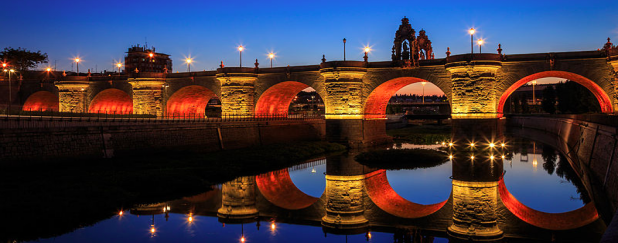MADRID
CENTER
SOUTH
NORTH
Back to up
Príncipe Pío
Príncipe Pío Station is a Madrid Metro and Cercanías station in Madrid city center. It was opened on December 27, 1925 and is one of the busiest station on the Madrid Metro and Cercanías system.
It has three levels. The highest level is elevated is used by Cercanías trains and has an island platform. The middle level is partially underground used by Madrid Metro lines 6 and 10 trains and has a dual-island platform (not a Spanish solution). Line 6 trains use the two inner tracks while Line 10 trains use the two outer tracks. The lowest level is used by Line R trains. It has two side platforms while both of them are used by trains to Ópera station.
The district is found over Quaternary terrains. There are several promontories in the ground: Bermejo, Cerro de la Piedra, Cerro de los Alemanes, Cerro de los Cuervos, Cerro de la Mica (the highest one) and Cerro Almodóvar.
The district was included in the 1845 administrative division of Madrid in 10 districts. It included all the so-called los Carabancheles districts which were added to the city of Madrid as the district of Carabanchel in 1948. In 1971 that district was divided in the three current districts: Usera, Carabanchel and Latina.
Latina
San Francisco
The Royal Basilica of San Francisco el Grande (in Spanish : Real Basílica de san Francisco el Grande) is a Roman Catholic church in central Madrid, Spain, located in the Barrio of La Latina. The main façade faces the Plaza of San Francisco, at the intersection of Bailén, the Gran Vía de san Francisco, and the Carrera de san Francisco. It forms part of the convent of Jesús y María of the Franciscan order. The convent was founded in the 13th century a the site of a chapel.
The basilica was designed in a Neoclassic style in the second half of the 18th century, based on a design by Francisco Cabezas, developed by Antonio Pló, and completed by Francesco Sabatini. The church contains paintings by Zurbarán and Francisco Goya. The temple once functioned as the National pantheon, and enshrined the remains of famous artists and politicians.
The dome is 33 m in diameter and 58 m in height; its shape is very similar to the Pantheon's dome, having a more circular shape than the typical domes built in the 18th century.

Puente de Toledo
Toledo Bridge is located in Madrid (Spain). Baroque style (churrigueresco) and was built between 1718 and 1732 by architect Pedro de Ribera. Une both banks of the Manzanares river, linking the roundabout Pyramids, on the east bank, with the square of the Marqués de Vadillo (Carabanchel), on the west bank.
Embajadores is a district of Madrid, belonging to the district center. Within this Lavapies neighborhood is considered by many as a proper barrio. It was the Jewish quarter of the city until the expulsion of the Jews from Spain in 1492, the church of San Lorenzo being built on the former site of the synagogue. The name literally means "wash feet", and may refer to the ritual washing of one's feet before entering the temple, possibly in the fountain in Plaza de Lavapiés which no longer exists.
Embajadores

Madrid Atocha (Spanish: Estación de Madrid Atocha, also named Madrid Puerta de Atocha) is the largest railway station in Madrid. It is the primary station serving commuter trains (Cercanías), intercity and regional trains from the south, and the AVE high speed trains from Barcelona (Catalonia), Zaragoza (Aragon), Seville (Andalusia) and Valencia (Levante Region). These train services are run by the Spanish national rail company, Renfe.
Memorials to the 2004 attack:
On 10 June 2004, a somber and minimalist Atocha station memorial was dedicated for the victims of the Attack. The monument includes a virtual shrine. Visitors to the attacked stations can leave a hand silhouette and a message through special-purpose consoles. A second monument to this event, known as 11-M in Spain, is the Bosque del Recuerdo ("the Forest of Remembrance") in the Parque del Buen Retiro near Atocha. This monument is made up of 192 olive and cypress trees, one for each person who died on that day, with a tree also planted in remembrance of the police officer who died on 3 April 2004, along with seven of the perpetrators whose capture was underway. Initially inaugurated as the Bosque de los Ausentes ("Forest of the Departed"), on the first anniversary of the devastating attack, on 11 March 2005, the site was renamed the following year. The forest is surrounded by a stream, with water as the symbol of life.
Atocha